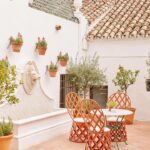Welcome to the second iteration of Vogue’s global spa guide, an index of the 100 best spas in the world, built from the expertise of our global editors and trusted contributors. There is a lot to choose from in the world of wellness, and no matter how far you’re planning to travel—from a subway ride to a trans-Atlantic flight—we want to make sure it’s worth the journey. Whatever your path, let us be your guide.
Why go here?
Say “the Cotswolds” to any seasoned traveler and a vision of classic British countryside living quickly springs to mind—streets lined with chocolate-box cottages, sweeping meadows dotted with cows and trimmed with wildflowers—which Thyme delivers in spades. Over the past two decades, the Hibbert family has slowly evolved this rambling collection of buildings in the village of Southrop into a 150-acre paradise that now encompasses a farm, restaurant, pub, and 31 rooms spread across the various barns, manor houses, and outbuildings that make up the estate. (Plus, of course, the Meadow Spa—but more on that later.)
Just as integral to the Thyme experience, though, is their homewares brand. Not content with having established a beloved countryside getaway for weary Londoners, a few years back, Caryn Hibbert—in collaboration with her daughter, Milly, who now works as the property’s general manager—launched Bertioli, which produces wallpapers, textiles, and an array of beauty and wellness products. (As much as the Hibberts like to keep things in the community, with most of the staff coming from the surrounding villages, they also like to keep things in the family: Their son, Charlie, is head chef at the Ox Barn restaurant and The Swan pub nearby, while Bertioli’s name stems from that of Caryn’s father.)
“The collections enable our guests to truly take a piece of Thyme home,” Hibbert says of what prompted her to launch Bertioli. “It’s the next chapter in our story—it’s what we call the coloring in.” Coloring in quite literally: Every one of the Bertioli wallpapers and textiles is created from watercolors painted by Hibbert herself, lending the rooms a soothing, earthy spirit, and every room is perfumed with bespoke scents inspired by local flora. Thyme is a very English kind of holistic retreat.
Photo: Courtesy of Thyme
What’s the vibe?
On a recent visit to Thyme in early spring, I quickly discovered that the dialogue between the hotel and its surroundings is infused into every aspect of your stay—especially, that aptly named Meadow Spa. It is Thyme’s very own “village within a village,” spread across various outbuildings and with a wildly pretty spring water pool crafted from black slate just around the corner. Perfect for cooling off in the warmer months, yes, but in the winter you can also retreat into the glass-walled Orchid House for a pot of tea (herbs plucked from the nearby garden, naturally) and a light salad or quiche, next to a roaring fire. In an especially charming touch, the spa reception is housed in a light-filled greenhouse with sage colored floor tiles, the walls covered with bookshelves and giant rustic urns overflowing with wildflowers, and white wrought iron furniture to sip tea (always more tea) before your appointment.
Photo: Courtesy of Thyme
The history?
Established by the Hibberts in 2002, who first moved to the village from London to open a cookery school, Thyme is all about honoring the rich history of the buildings. There’s a Saxon church that is part of the complex with a font dating back to the 12th century, while the 17th century manor houses—one occupied by the Hibberts, the other converted into guest rooms—have been lovingly restored to include every luxurious detail you might be seeking, while still featuring plenty of quirks that speak to their fascinating backstories.
Photo: Courtesy of Thyme
What should you try?
The star of the show here, in terms of spa treatments, is the Botanical Bothy Signature Ritual. After being guided to the dedicated bothy—a kind of rustic spin on a hammam with tables crafted from natural resin, and an outdoor bathtub and private garden to enjoy a sage and honey tea while soaking post-treatment—I was led on a genuinely transformative ritual that began with a breathing exercise aided by a fragrant balm, featuring river mint and eucalyptus inspired by the nearby water meadow.
Read the full article here




